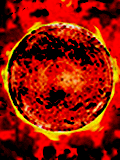Quantitative Lesson 43 "Latin Names and Greek Prefixes"
Science and Technology Standards:
PA Standard 3.4.10A: Classify and describe, in equation form, types of chemical and nuclear reactions
Anchor Assessment S11.A.1.1: Analyze and explain the nature of science in the search for understanding the natural world and its connection to technological systems.
Anchor Assessment S11.A.1.2: Identify and analyze the scientific or technological challenges of societal issues; propose possible solutions and discuss implications.
Anchor Assessment S11.A.1.3: Describe and interpret patterns of change in natural and human-made systems.
Anchor Assessment S11.A.2.1: Apply knowledge of scientific investigation or technological design to develop or critique aspects of the experimental or design process.
Anchor Assessment S11.A.2.2: Evaluate appropriate technologies for a specific purpose, or describe the information the instrument can provide.
Anchor Assessment S11.A.3.2: Compare observations of the real.
Anchor Assessment S11.A.3.3: Compare and Analyze repeated processes or recuring elements in patterns.
Anchor Assessment S11.B.1.1: Explain structure and function at multiple levels of organization.
Anchor Assessment S11.C.1.1: Explain the relationship between the structure an properties of matter.
Purpose:
1. I will name various compounds.
Homework Due:
1. Review IUPAC Naming
Handouts/Supplies:
1. Nomenclature WS #3
I. Introduction
Opening Assignment:
Warm-Up: Name the following compound, Hg2O.
Review warm-up
State the purpose
II. The Lesson:
Activity #1: Review the name of Hg2O
Activity #2: Review the steps for IUPAC naming 1. Identify binary/polyatomic compounds
2. Identify metals/nonmetals
3. Identify type I/II oxidation states
4. Name binary metal type I compounds
5. Name polyatomic metal type I compounds
6. Identify oxidation states of type I compounds (anion → cation) a. noble gas' electron configuration (8)
b. electron configuration
c. loss or gain of electrons
d. charge
e. roman numerals (s and p subshells only) 7. Identify oxidation states of type II compounds (anion → cation)
8. Name binary metal type II compounds
9. Name polyatomic metal type II compounds
10. Identify nonmetal oxidation states of compounds (anion → cation)
11. Name binary nonmetal compounds Activity #3: Discuss latin names for type II metals
Activity #4: Complete Nomenclature WS 1: 2, 3, 7, & 13
Activity #5: Review Nomenclature WS 1: 2, 3, 7, & 13
Activity #6: Complete Nomenclature WS 2: 3, 7, 11, & 13
Activity #7: Review Nomenclature WS 2: 3, 7, 11, & 13
Activity #8: Discuss greek prefixes for binary type II nonmetals
Activity #9: Complete Nomenclature WS 1: 10 & 11
Activity #10: Review Nomenclature WS 1: 10 & 11
Activity #11: Complete Nomenclature WS 2: 4, 17 & 19
Activity #12: Review Nomenclature WS 2: 4, 17 & 19
Activity #13: Review Nomenclature WS 2: 1 - 10
Activity #14: Complete IUPAC names, latin names, & greek prefixes for Nomenclature WS 3: 1 -5
Activity #15: Review Nomenclature WS 3: 1 - 5
Activity #16: Complete IUPAC names, latin names, & greek prefixes for Nomenclature WS 3: 6 - 20
III. Closure:
Summary Assignment:
Summarize today's lesson
1. I will name various compounds.
Homework Assignment (Write down in planners):
1. Nomenclature WS #3
Preview of Next Class:
1. Nomenclature Flowchart
Page maintained by: Stephen A. Roe
Last update: Tuesday, October 24, 2006 11:49 AM
|

